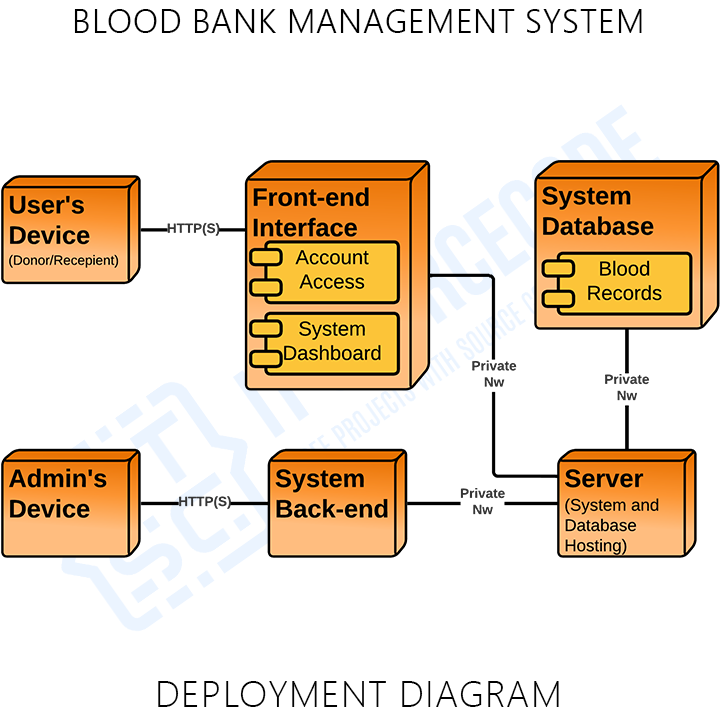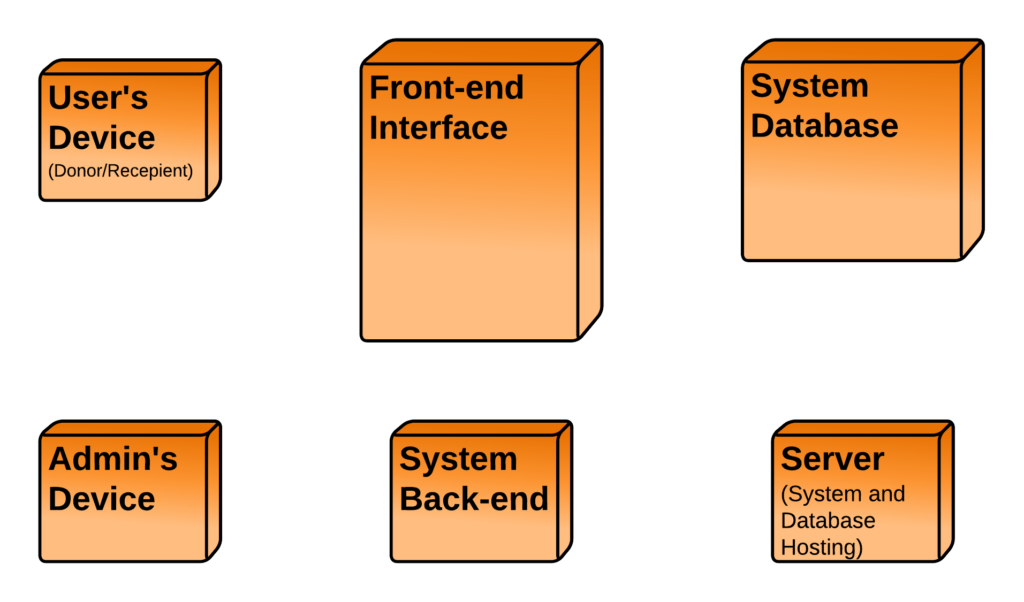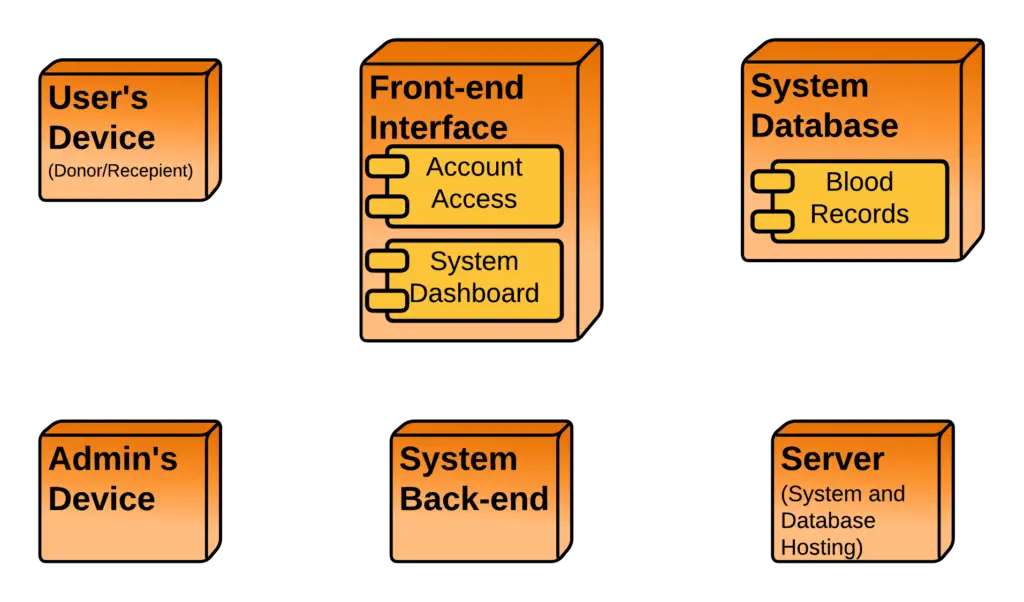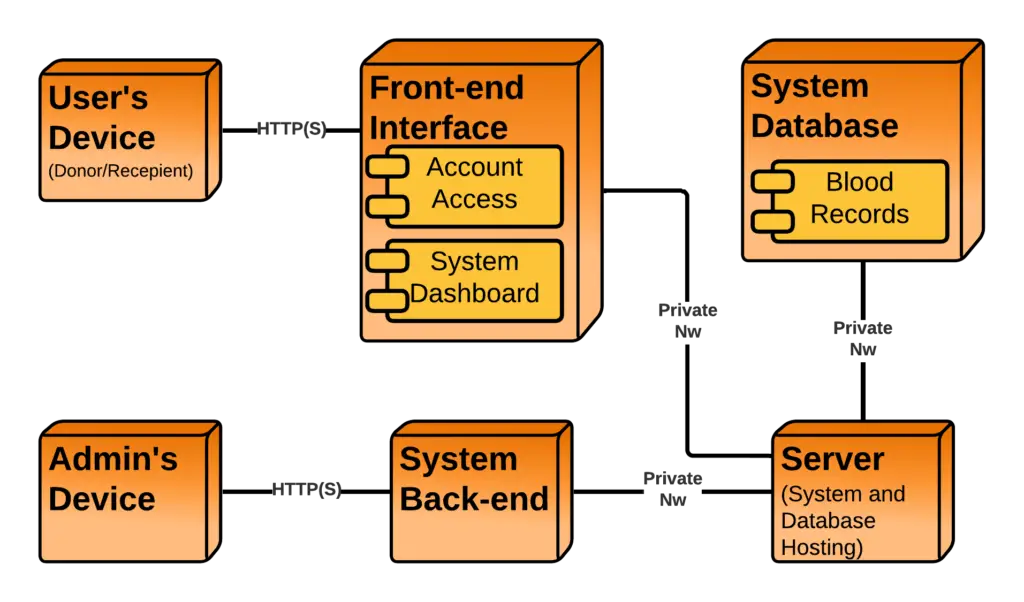What is Blood Bank Management System Deployment Diagram?
A deployment diagram for blood bank management system is used to describe the system’s operation showing the hardware and software components that run in each node, and explaining the connections between them.
Blood Bank Management System Deployment Diagram: Table of contents
- What is Blood Bank Management System Deployment Diagram?
- Deployment Diagram for Blood Bank Management System: Content
- Blood Bank Management System Deployment Diagram Description
- Deployment Diagram for Blood Bank Management System
- Blood Bank Management System UML Deployment Diagram (Explanation)
- Deployment Diagram for Blood Bank Management System (PDF)
- UML Deployment Diagram for Blood Bank Management System
- Steps in Developing Blood Bank Management System Deployment Diagram
- Conclusion:
- Recommended Articles from the Author:
- Inquiries
Deployment Diagram for Blood Bank Management System: Content
The table shows the basic details of the deployment diagram of blood bank system. It has quick description details of the project.
| Name: | Blood Bank Management System Deployment Diagram |
| Abstract: | The blood bank system deployment diagram represents the physical structure of the project. It reveals the software and hardware included for the application to work correctly. |
| UML Diagram: | Deployment Diagram |
| Users: | Hospital/Bloodletting Admin, Donors, and Recipients. |
| Tools Used: | Diagraming Tools that have UML Deployment Diagram Symbols |
| Designer: | ITSourceCode.com |
Blood Bank Management System Deployment Diagram Description
All blood donated at blood drives must be treated safely and efficiently so that individuals in need of blood do not contract infections or illnesses. The Blood Bank Management System (BBMS) is a web-based system that can assist with blood bag information while in the blood bank. The person using this system can put in the results of the blood tests that have been done on each blood bag that the blood bank has received.
It is meant to store, process, retrieve, and analyze data related to the management of a blood bank’s inventory and administrative tasks. The blood bank software allows patients to obtain information about the blood group they require from the central inventory. If the blood group required is not available in the central inventory, a centralized blood bank information system assists patients in obtaining a list of donors by area or blood group.
Deployment Diagram for Blood Bank Management System
The nodes included in the blood bank management system deployment diagram are represented by boxes. These boxes are labeled as software or hardware that specifies the included components to carry out the bloodletting process. The boxes will then be connected and labeled to declare the type of connection they have with the other components.

The core functions of blood bank management are contained in the Blood Bank Management System. This system makes use of server hosting to hold the software and its database. The function modules are user account management (see stock list), donor registration, and recipient registration.
This system allows people who want to donate blood to help those in need. It also provides a consolidated blood bank database and allows hospitals to record and keep data for those who want to contact them.
Blood Bank Management System UML Deployment Diagram (Explanation)
The Blood Bank Management System UML deployment diagram explains the sketch of the relationship between software and hardware. These hardware and software are labeled to clarify their part in the system’s operation. They were represented by nodes and the connections were represented by labeled arrows.
The deployment diagram shows the scenario when the system is deployed. It has 4 nodes represented with boxes and relationship connections. The nodes are the blood bank management system, the customer’s device, the admin’s device, and the database (system server). The system server node contains a developed database that will hold the details of the system online.
For the connection, the system is connected to the server database using a private network which enables it to pass a connection to the devices and enable users to access the system and database. The admin and the customer then can communicate using an online or internet connection.
Deployment Diagram for Blood Bank Management System (PDF)
You may download the Deployment Diagram for Blood Bank System PDF by clicking the button below. It has the full details and discussion on System’s Deployment Diagram. You can also modify its content to complete your project requirements and needs.
UML Deployment Diagram for Blood Bank Management System
A deployment diagram for the blood bank management system in UML is used to illustrate its’ physical architecture. In UML, deployment diagrams can show you how the software and hardware of the learning system work together and where the processing takes place.
The blood bank management system uses a UML deployment diagram to show how should the developed software be deployed. It clarifies the communications between links(nodes) which helps the project to work according to the design given to it. Deployment diagrams depict the setup of run-time processing nodes and the components that reside on them.
Steps in Developing Blood Bank Management System Deployment Diagram
Time needed: 10 minutes
Here are the steps in developing the blood bank system deployment diagram.
- Determine the diagram’s purpose.
To determine the purpose of the deployment diagram, know the description of the blood bank system. The purpose of the deployment diagram is to design the needed components (software and hardware) of the system. This is to support and imply the whole processes when the blood bank management operates.
- Add the diagram’s nodes.
The term “node” refers to the physical devices that make up the system. Artifacts are deployed on these nodes. Node instances on which artifact instances will be implemented are also possible.

The essential software or hardware elements, or nodes, in the system are represented by the three-dimensional boxes known as nodes. The smaller forms included within the boxes reflect the software artifacts that are distributed, and the lines from node to node indicate relationships. - Add more pieces to the diagram, such as components or artifacts, if needed.
A deployment diagram depicts the locations of components and artifacts in the deployed system. In a software system, artifacts are model elements that reflect physical entities. Executable files, libraries, software components, documents, and databases are examples of physical implementation units.

- Add communication associations.
A communication association (path) is a sort of relationship between nodes in a deployment diagram that indicates how they communicate messages and signals in UML modeling. Deploy relationships in UML show that a certain type of node can be used to deploy a certain type of artifact.

A message or other sort of communication between nodes is indicated by a line called a relation or association.
Additional Knowledge
The topology of the physical components of a system, where the software components are installed, is visualized using deployment diagrams. Deployment diagrams are used to depict a system’s static deployment view. Nodes and their relationships are depicted in deployment diagrams.
The Deployment Model shows how components will be distributed across the system architecture in detail. It contains information about network capabilities, server specifications, hardware requirements, and other aspects of the planned system’s deployment.
Conclusion:
You need to know the diagrams used to design and develop the Blood Bank Management System. That is because you cannot perfectly create a fully-functional system without it. But if you create this deployment diagram, you will know the software and hardware components that the project should possess. Not only that, you will find out the needed specifications and connect them to the other UML Diagrams.
The deployment diagram is used to model the system’s physical architecture. It describes the connections of components between software and hardware system. By completing the Diagrams per module or per process, you will easily achieve your desired system. Check out our Related and Recommended Articles for more Learning and Information.
Related Articles:
- Deployment Diagram for Car Rental System
- Deployment Diagram for Employee Management System
- School Management System Deployment Diagram
- Deployment Diagram for Student Management System
- Deployment Diagram for Point of Sale System
Recommended Articles from the Author:
- Blood Bank Management System Activity Diagram
- Blood Bank Management System UML Diagrams
- Online Blood Bank Management System Class Diagram
- Blood Bank Management System Sequence Diagram
- Blood Bank Management System Use Case Diagram
Inquiries
If you have inquiries or suggestions about Deployment Diagram for Blood Bank Management System, just leave us your comments below. We would be glad to hear to concerns and suggestions and be part of your learning.
Keep us updated and Good day!




